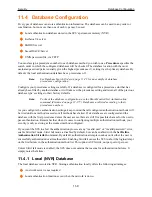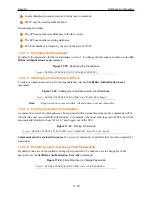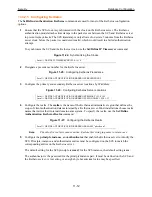
Security
User Restrictions
11-21
11.5.5 Locking a Port
The Lock command may be used to secure a port without disconnecting sessions. When
Lock
is entered,
the user will be prompted to enter a password. This port will then be locked until this password is used to
unlock it. Figure 11-40 displays an example:
Figure 11-40:
Locking and Unlocking a Port
Note:
Secure ports (set using the Set/Define Ports Security command) cannot be
locked.
To unlock a port without the Lock password, a privileged user must use the
Unlock Port
command
(discussed on page 12-100) or log out the port using the
Logout Port
command (discussed on page 12-53).
Logout will disconnect all sessions.
11.5.6 Forcing Execution of Commands
When a username is entered in the local authentication database (NVR), a series of commands may be
associated with that user. These commands will be executed when the user is successfully authenticated.
To execute commands when the user logs into the SCS, first ensure that authentication databases have been
configured; see
Database Configuration
on page 11-9 for instructions. Then associate commands with the
username using the
Set/Define Authentication User Command
command. The commands you specify
will be executed when the user is successfully authenticated.
Figure 11-41:
Forcing User to Start a Particular Site
In the previous example, when user bob logs into the SCS, he will automatically start PPP and run the site
dialin_users.
To ensure that the user is not left at the Local> prompt after the forced command finishes executing, the
string “;logout” may be added.
11.5.7 Restricting Multiple Authenticated Logins
The
Set/Define Authentication Unique Enabled
command can be used to prevent a single PPP or Local
mode user from making multiple authenticated connections to the SCS.
For example, imagine that ports 1 through 8 have authentication enabled, but ports 9 through 16 do not. If
user george connects to port 2 and enters the correct password, he will be permitted to login. If, while george
is connected to port2, another user tries to log into port3 using george as his username, he will be rejected.
Local> LOCK
Password> donut (not echoed)
Verification> donut (not echoed)
Unlock password> donut (not echoed)
Local>
Local>> DEFINE AUTHENTICATION USER bob COMMAND "SET PPP dialin_users; logout"
Summary of Contents for SCS
Page 14: ...xii ...
Page 171: ...Modem Sharing Examples 10 6 ...
Page 314: ...Command Reference Service Commands 12 110 ...
Page 403: ...Show 802 11 Errors Rightmost Number B 5 00000002 Internal error 00000001 Internal error ...
Page 424: ...Index 13 ...






























